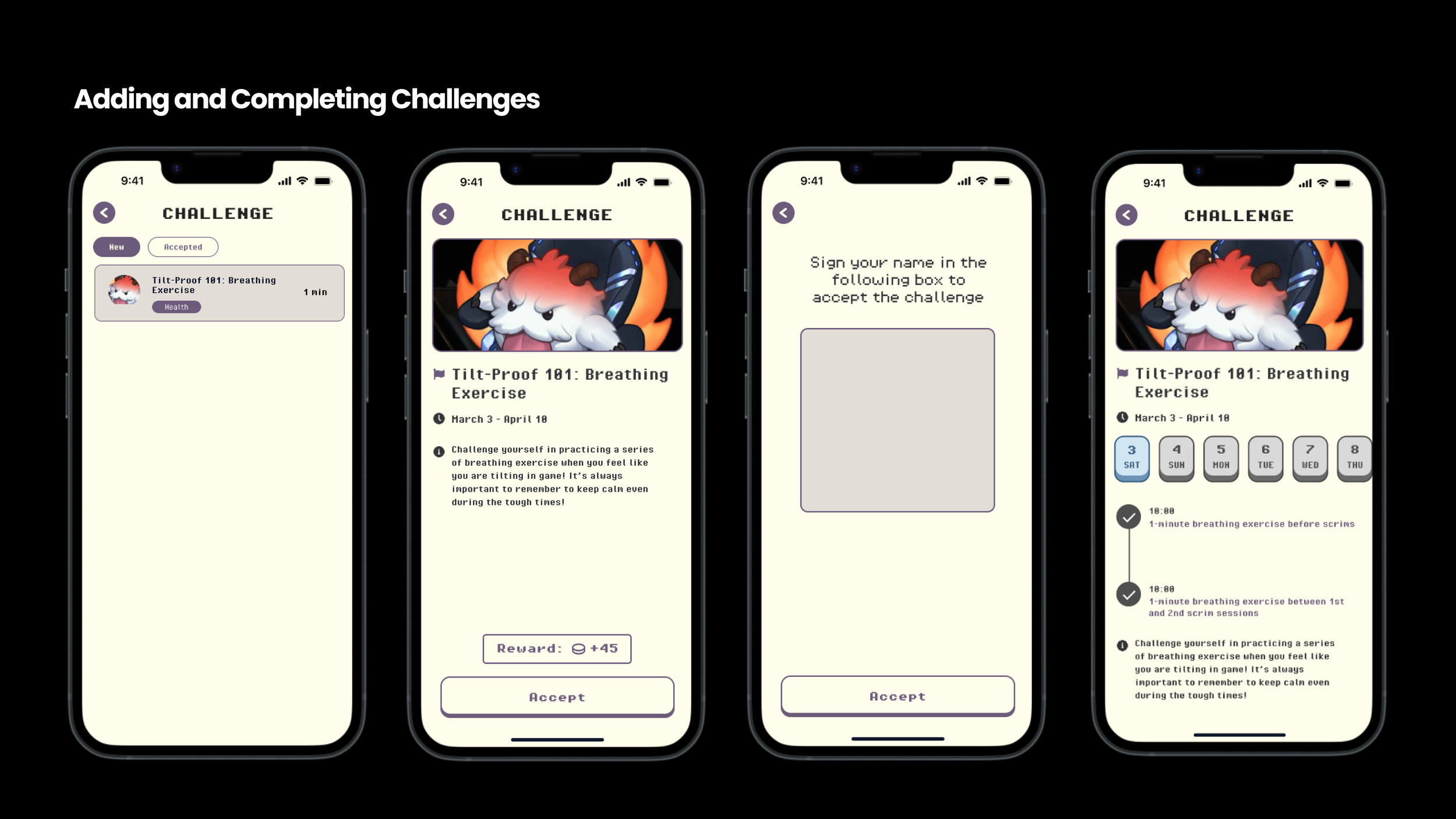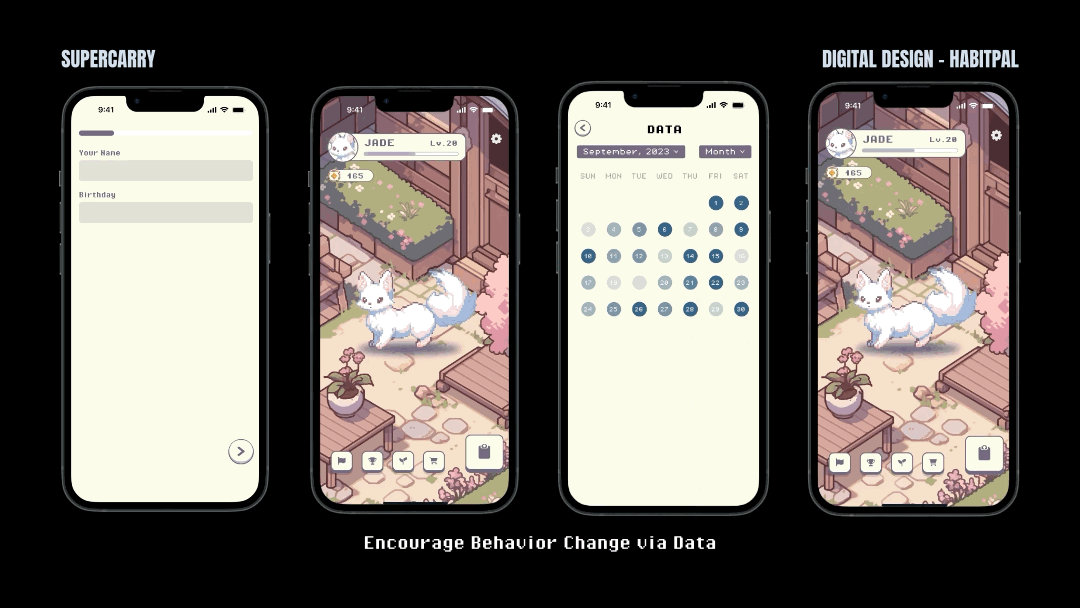HabitPal
Habit Tracking App
Company: School of Visual Arts (Thesis)
Role: User Interface Designer, User Researcher
Duration: September 2023 - May 2024
Scope: User Research, Interface Design
Tool(s): Figma, Adobe Photoshop, Miro
About
HabitPal is a TTRPG-styled habit-tracking app that is part of the grad school thesis work, SuperCarry: Fostering a Wellness Approach to Enhance Career Longevity in Esports Players for the School of Visual Arts MFA Products of Design. It is designed for esports players who seek to enhance their gaming performance through proactive health and well-being steps, offering a series of holistic and interactive solutions tailored to their needs
Role
Throughout the thesis year, I was the sole designer for my projects. For this digital product sector, I conducted user research, interviews, and product development.
How might we motivate esports players, who understand the critical link between well-being and performance but often neglect their health in favor of prolonged practice sessions, to independently adopt and maintain healthy lifestyle habits?
Despite the availability of various products, most lacked specificity and engagement for esports players. One platform, FITGMR, designed specifically for esports players, offered clean and concise layouts but failed to sufficiently engage users to ensure their return. Other apps, such as Headspace, Pokemon Sleep, and Habitica, incorporate gamification to enhance user experience. However, their lack of esports-specific elements and reliance on in-game items as rewards may not sustain long-term interest among players.
Challenge
Introducing a TTRPG-styled app with holistic and interactive solutions that appeal to users’ (esports players) preferences and challenges.
Solution
Before diving into the development of the app, I conducted online co-creation workshops with current collegiate League of Legends players, as well as interviews with coaches, health professionals, and pro players from other games (Call of Duty). The co-creation workshop consisted of a series of Mundo Dodgeball and a round of All-Random-All-Mid in the League of Legends client, followed by a roundtable discussion on the Miro board. The reason that I decided to host the workshop on the League client (and it was particularly effective) was that it allowed participants (collegiate League of Legends players) to engage in a sensitive conversation in a more familiar and comfortable environment, with direct feedback and fostering easy communication on their experience.
One of the major findings that I summarized from my research is that players do have an understanding of maintaining good physical and mental conditions. Despite this understanding, however, they would continue to neglect these conditions in order to have more time for performance training. The reasons that lead to this kind of behavior are the following:
The competitive nature of the esports field is very similar to the traditional sports field, where players want to rank the highest and believe that “if I continue to grind through the games and practices non-stop, I will get better.” This could be true to a certain extent, as some games require game knowledge (e.g., the functions of each character and category of character, the mechanics of in-game tools/items, the layouts of different maps); on top of this, the fact that the games constantly update requires players to put a lot of effort into memorizing and understanding in order to play well. Moreover, muscle memory and reflexes are also essential, as many in-game situations require players to react and make decisions with split-second timing.
The phenomenon of ignoring pain or grinding through games with a fever is not uncommon in the field. Players tend to ignore poor physical or mental conditions due to stigma. Many believe that they could “handle it later,” which is not true—it could lead to a more severe condition that impacts not only their wellness but also their in-game performance and even their ability to play.
Another thing to mention is that although some teams have health professionals to guide the players through their wellness plans, the main responsibility still lies with the team coaches. In fact, in the esports field, very few teams have the resources to hire specific health professionals due to the financial cost. Therefore, many coaches are required to acquire basic health-related knowledge on top of game coaching. In comparison, in the traditional sports field, athletic trainers are the ones who are in charge of players’ health practices. Esports team coaches are treated as the “parent(s)” of the players; they not only coach the players on their in-game strategies and performance but are also the ones players tend to confide their real-life problems.
“But sometimes we can only do so much about coaching the players regarding lifestyle choices and habits. At the end of the day, it relies on THEIR own disciplines to develop the habits. That’s why I always try to take them out to gym and workout etc.”
—— Sean “Seanatonin” Shannon, Coach for Illinois Wesleyan University and Head Coach for Xora Esports
Existing Products
I began to look into existing products in the market, including MyFitnessPal, Strava, Productive, Me+, and Flora. I also looked into other apps that involve a gamification process, such as Pokemon Sleep, Habitica, and Headspace. One of my friends who works in the industry also gave me a suggestion called FITGMR, which is designed specifically for esports players. However, as I looked deeper into these existing products, I found the following issues as to why they are not as effective:
Lack of Specificity to Esports: Most of the apps listed are designed for a general audience, focusing on common goals like fitness, diet, and productivity. They lack features tailored to the specific demands of esports, such as managing extensive screen time, optimizing mental focus for long gaming sessions, and balancing a sedentary lifestyle with physical health.
One-Size-Fits-All Approach to Wellness: Existing wellness solutions often overlook the specific challenges of esports athletes, such as intense concentration, disrupted sleep from irregular schedules, and the need for exercises to offset prolonged sitting, making general apps like Headspace insufficient for esports-specific needs.
Not Stimulating Enough: Gamers, accustomed to dynamic and detailed interfaces in video games, find the minimalist designs of most habit-tracking and wellness apps unengaging, leading to decreased interest and engagement due to the stark contrast in user experience.
Inadequate Reward Incentives: General wellness apps often miss the mark with reward incentives for gamers, offering simplistic rewards that don't align with their motivations, leading to lower adherence rates due to the lack of engaging mechanisms compared to the instant, high-engagement rewards in gaming.
Initial Design & Feedback
I summarized a solution based on these issues: By crafting an engaging platform that stimulates their gaming instincts and drives action, we can bridge the gap between awareness and action. This approach encourages players to naturally integrate healthy habits into their routines, effectively boosting their performance while maintaining their commitment to gaming. Essentially, I would need to come up with a solution specifically designed for the unique mindset of esports players, who recognize the critical role of well-being in achieving peak performance yet often sideline their health in favor of intense training sessions.
Initially, I created low-fidelity frames based on a more clean and minimalistic style. Some of the feedback that I got from showing my initial frames are the following:
“By looking at the low-fi frames I can already predict that it feels like a very typical habit tracker app vibe.”
“The question that I have for you is that why would the target user [esports players] care—like what is the point of this app?”
“Think about what draws players in without them ‘cheesing’ through the stages to get rewards—you want them to ENJOY the process of using this app and not make it a hassle.”
This feedback made me realize that I was already falling back into the loophole of “making this a minimalistic app.” Therefore, I wanted to gamify the app a bit more because, as gamers, players are naturally drawn to the mechanics of GAMING. Features such as earning points, completing challenges, and unlocking achievements make the process of adopting healthy habits more engaging and enjoyable, which mirrors the rewarding experiences they find in their competitive gaming experience. Incorporating the elements of the slice-of-life genre and Tabletop RPG elements capitalizes on the power of storytelling, community, and personal growth.
In the reiteration phase, I decided to gamify the app and turn it into a slice-of-life/tabletop RPG style. In terms of UX writing, I utilized keywords such as earning points, completing challenges, and unlocking achievements. These kinds of mechanics remind users of relaxation games that they would go to after scrimmages (ex. Minecraft, Stardew Valley), which makes the process more encouraging and enjoyable.
Reiteration
In order to create an intuitive and enjoyable interface, I designed the system of the app, as well as the app logo and mascots (with Midjourney).
Branding & System
Created with Midjourney





















